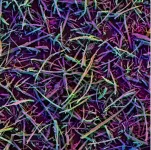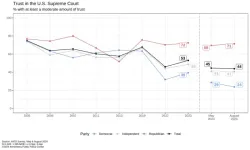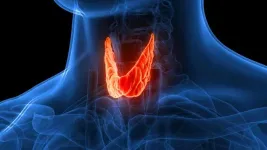(Press-News.org) Endosymbiosis is a fascinating biological phenomenon in which an organism lives inside another. Such an unusual relationship is often beneficial for both parties. Even in our bodies, we find remnants of such cohabitation: mitochondria, the powerhouses of our cells, evolved from an ancient endosymbiosis. Long ago, bacteria entered other cells and stayed. This coexistence laid the foundation for mitochondria and thus the cells of plants, animals, and fungi.
What is still poorly understood, however, is how an endosymbiosis as a lifestyle actually arises. A bacterium that more or less accidentally ends up in a completely different host cell generally has a hard time. It needs to survive, multiply, and be passed on to the next generation. Otherwise, it dies out. And to not harm the host, it must not claim too many nutrients for itself and grow too quickly. In other words, if the host and its resident cannot get along, the relationship ends.
To study the beginnings of such a special relationship between two organisms, a team of researchers led by Julia Vorholt, Professor of Microbiology at ETH Zurich, initiated such partnerships in the laboratory. The scientists observed what exactly happens at the beginning of a possible endosymbiosis. They have just published their study in the scientific journal Nature.
Enforcing cohabitation
For this work, Gabriel Giger, a doctoral student in Vorholt's laboratory, first developed a method to inject bacteria into cells of the fungus Rhizopus microsporus without destroying them. He used E. coli bacteria on the one hand and bacteria of the genus Mycetohabitans on the other. The latter are natural endosymbionts of another Rhizopus fungus. For the experiment, however, the researchers used a strain that does not form an endosymbiosis in nature. Giger then observed what happened to the enforced cohabitation under the microscope.
After the injection of the E. coli bacteria, both the fungus and the bacteria continued to grow, the latter eventually so rapidly that the fungus mounted an immune response against the bacteria. The fungus protected itself from the bacteria by encapsulating them. This prevented the bacteria from being passed on to the next generation of fungi.
Bacteria enter the spores
This was not the case with the injected Mycetohabitans bacteria: While the fungus was forming spores, some of the bacteria managed to get into them and thus were passed on to the next generation. “The fact that the bacteria are actually transmitted to the next generation of fungi via the spores was a breakthrough in our research,” says Giger.
When the doctoral student allowed the spores with the resident bacteria to germinate, he found that they germinated less frequently and that the young fungi grew more slowly than without them. “The endosymbiosis initially lowered the general fitness of the affected fungi,” he explains. Giger continued the experiment over several generations of fungi, deliberately selecting those fungi whose spores contained bacteria. This enabled the fungus to recover and produce more inhabited but viable spores. As the researchers were able to show with genetic analyses, the fungus changed during this experiment and adapted to its resident.
The researchers also found that the resident, together with its host, produced biologically active molecules that could help the host obtain nutrients and defend itself against predators such as nematodes or amoebae. “The initial disadvantage can thus become an advantage,” emphasizes Vorholt.
Fragile systems
In their study, the researchers show how fragile early endosymbiotic systems are. “The fact that the host's fitness initially declines could mean the early demise of such a system under natural conditions,” says Giger. “For new endosymbioses to arise and stabilize, there needs to be an advantage to living together,” says Vorholt. The prerequisite for this is that the prospective resident brings with it properties that favor endosymbiosis. For the host, it is an opportunity to acquire new characteristics in one swoop by incorporating another organism, even if it requires adaptations. “In evolution, endosymbioses have shown how successful they ultimately can become,” emphasizes the ETH professor.
END
How a bacterium becomes a permanent resident in a fungus
2024-10-02
ELSE PRESS RELEASES FROM THIS DATE:
Study: For long COVID, lithium aspartate at low doses is ineffective, but higher doses may be promising
2024-10-02
BUFFALO, N.Y. — A small University at Buffalo clinical trial has found that at low doses, lithium aspartate is ineffective in treating the fatigue and brain fog that is often a persistent feature of long COVID; however, a supplemental dose-finding study found some evidence that higher doses may be effective.
Published in JAMA Network Open on Oct. 2, the study was led by Thomas J. Guttuso, Jr., MD, professor of neurology in the Jacobs School of Medicine and Biomedical Sciences at UB and a physician with UBMD Neurology.
“It’s a negative study with a positive twist,” Guttuso concludes.
Because ...
Online insomnia treatment can help caregivers get much-needed rest, study suggests
2024-10-02
Providing care for a family member with a disabling illness can be a demanding job that leaves many people unable to sleep, but an online insomnia treatment developed at the University of Virginia School of Medicine can help, new research shows.
Not only did the SHUTi (Sleep Healthy Using the Internet) sleep intervention help caregivers get better rest, it most benefited those shouldering the greatest responsibilities in caring for their loved ones, the researchers found.
The results suggest the online format of the program ...
Attivare licenses Wyss Institute’s immune-modulating biomaterial technology to advance immunotherapies
2024-10-02
Attivare licenses Wyss Institute’s immune-modulating biomaterial technology to advance immunotherapies
The company is developing the biomaterial-based technology to develop novel therapies able to program anti-cancer immunity and prevent infectious diseases
By Benjamin Boettner
(BOSTON) — Today, the Wyss Institute for Biologically Inspired Engineering at Harvard University and Attivare Therapeutics Inc. announced that Attivare has licensed a portfolio of immune-modulating biomaterial technologies from Harvard University that was created at the ...
Regenstrief, Fairbanks researcher among 25 fellows to be inducted into American College of Medical Informatics
2024-10-02
The American College of Medical Informatics (ACMI) has announced that Chris Harle, PhD, of the Indiana University Richard M. Fairbanks School of Public Health and the Regenstrief Institute will be inducted as one of 25 new fellows on November 10 in San Francisco, CA, at ceremonies during the American Medical Informatics Association (AMIA) 2024 Annual Symposium.
ACMI is a college of elected fellows who have made significant and sustained contributions to the field of biomedical informatics. Individuals who have achieved national recognition in the field and are committed to advancing ...
Ontario Institute for Cancer Research funding aims to speed the development of new drugs for some of the most common cancers
2024-10-02
October 2, 2024, TORONTO – The Ontario Institute for Cancer Research (OICR) continues to support Ontario drug discovery research by funding high-quality investigations of new therapies for some of the most prevalent pediatric and adult cancers. These projects are tackling substantial challenges in cancer by increasing the effectiveness and availability of immunotherapies, making cancer more vulnerable to chemotherapy and developing a new drug for one of the deadliest forms of childhood brain cancer.
OICR’s Cancer Therapeutics Innovation Pipeline (CTIP) initiative is supporting three research teams ...
Trust in US Supreme Court continues to sink
2024-10-02
PHILADELPHIA – Driven by political partisanship, public trust in the U.S. Supreme Court has continued a downward slide since the court’s 2022 Dobbs decision overturning the Roe v. Wade ruling that established a constitutional right to abortion, according to a new survey by the Annenberg Public Policy Center (APPC) of the University of Pennsylvania.
More than half of Americans (56%) now disapprove of the Supreme Court, saying they trust it either “a little” or “not at all” to act in the best interest ...
Rice’s Biotech Launch Pad to lead commercialization of bioelectrical implant treatment for obesity, type 2 diabetes
2024-10-02
Rice University is part of a multiuniversity research team that has secured an award of up to $34.9 million from the Advanced Research Projects Agency for Health (ARPA-H) to accelerate the development of a bioelectronic implant designed to improve adherence for obesity and type 2 diabetes (T2D) treatment while reducing development and manufacturing costs.
Rice University’s Biotech Launch Pad will lead the commercialization effort for “Rx On-site Generation Using Electronics” (ROGUE), a self-contained, durable implantable device that houses cells engineered ...
Carnegie Mellon to lead development of implantable cell-based bioelectronic devices for patient-specific treatment and disease monitoring
2024-10-02
PITTSBURGH – A Carnegie Mellon University-led team has secured an award of up to $42 million from the Advanced Research Projects Agency for Health (ARPA-H) to accelerate the development of implantable, cell-based bioelectronic devices that deliver patient-specific therapy and monitor disease status, for conditions like hypo- and hyperthyroidism, in real time. This award is part of the ARPA-H REACT program, which supports the advancement of implantable bioelectronic devices to improve patient management of chronic diseases.
Burak ...
Case Western Reserve, Vanderbilt universities to develop incisionless prostate surgery using MRI and robotics
2024-10-02
CLEVELAND—Researchers at Case Western Reserve University and Vanderbilt University are pioneering a new approach to prostate cancer surgery by combining advanced robotics and “low-field” MRI technology.
The research aims to allow highly accurate, patient-tailored prostate cancer surgeries without the need for traditional incisions. This innovative research marks a major step in developing minimally invasive treatments for prostate cancer, with the potential to improve both safety and efficiency for patients.
The project is being funded by a new five-year, $3.7 million grant from the National Cancer Institute, part of the ...
Carnegie Mellon University secures ARPA-H award to improve adherence, lower cost of treatment for obesity and Type 2 diabetes patients
2024-10-02
PITTSBURGH – A Carnegie Mellon University-led team of researchers has secured an award of up to $34.9 million from the Advanced Research Projects Agency for Health (ARPA-H). The funds will fast track a bioelectronic implant that could radically improve treatment options and significantly reduce the cost of care for patients with obesity and Type 2 diabetes.
The award will drive the accelerated development and testing of “Rx On-site Generation Using Electronics (ROGUE),” a bioelectrical device that hosts a “living pharmacy,” consisting of engineered cells that produce biological therapy to treat Type 2 diabetes and obesity. The device will offer continuous, ...






